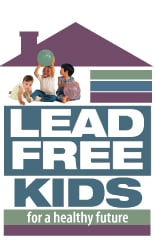Protect Your Children...Learn About Lead!
On This Page
- Product Recalls
- What is childhood lead poisoning?
- Test children for lead
- Are all children at risk for being exposed to risk
- How do children get lead poisoning?
- How to protect children from lead poisoning
- What your child’s blood lead test results mean
- Lead paint removal and remodeling safety
- Learn more about lead
- Posters & Fliers
What is childhood lead poisoning?
Lead poisoning is a serious health problem for children. Studies show that no amount of lead exposure is safe for children. Lead is a metal that can harm children when it gets into their bodies. Lead can harm a young child's growth, behavior, and ability to learn.
What are the dangers of lead?
Lead poisoning damages growing cells and tissues and can cause any of the following problems in children:
- Lower IQ
- Hearing loss
- Anemia
- Kidney damage
- Growth problems
Testing for lead
It’s the law in New York State!
The NYS Law requires your child’s healthcare provider to take the following prevention measures:
- Obtain a blood lead test for all children at age 1 and again at age 2.
- Assess all children ages 6 months to 6 years for risk of lead exposure at least annually and provide lead exposure prevention guidance to their parents as part of routine care.
- Make certain any child with an elevated lead level has appropriate follow-up testing and medical management.
Your healthcare providers may use a risk assessment questionnaire to determine if your child is at higher risk of lead poisoning.
“At one and two, testing for lead is what you do.”
How do children get lead poisoning?
For many years most house paints were made with lead in them. For that reason the paint in a lot of older homes contains lead. A new coat of paint may cover up the danger, but it won't fix it. In an older house, your child can easily be exposed to the lead in these ways:
- Chipping and crumbling plaster walls can expose the old lead paint and the danger returns.
- Dust from cracking paint or plaster that settles on toys, food, bedding or other things children might rub their face into or put into their mouth..
- Hot Water from old lead pipes.
There are many other ways in and outside of the home that children can be exposed to. There's more info here, Do You Know Where Lead May Be Hiding? (PDF)
If your child has lead in his or her blood, new and growing cells and tissues continue to be damaged. The more lead in your child's blood, the more damage it causes.

How to protect children from lead poisoning.
Keep your child away from sources of lead.
- find out if there is a dangerous amount of lead in your house or apartment.
- keep children away from peeling paint and broken plaster.
- wash your child's hands and face often to remove any lead dust or dirt.
- wash your child's toys often, especially teething toys.
Keep your home or apartment free of lead.
- have the paint and plaster on your walls tested for lead before you renovate or remodel.
Keep your community safe from lead poisoning.
- work to keep lead dust out of the environment. If you see uncontrolled grinding or sanding of exterior paint in your residential area, find out if the surfaces have been tested for lead. Or notify the Tompkins County Health Department at (607) 274-6688.
What Your Child’s Blood Lead Test Means
The blood lead test tells you how much lead is in your child's blood. Lead can harm a child's growth, behavior, and ability to learn. The lower the test result, the better.
Most lead poisoning occurs when children lick, swallow, or breathe in dust from old lead paint. Most homes built before 1978 have old lead paint, often under newer paint. If paint peels, cracks, or is worn down, the chips and dust from the old lead paint can spread onto floors, windowsills and all around your home. Lead paint dust can then get onto children's hands and toys, and into their mouths.
Most children have had some contact with lead in old paint, soil, plumbing, or another source. This is why New York State requires doctors to test all children with a blood lead test at age 1 year and again at age 2 years. For children up to age six years, at every well child visit your healthcare provider should ask you about ways your child may have had contact with lead. Your child should be tested if they had contact with lead.
If a test result is shows high levels using blood from a fingertip, the child should be checked again with a second test using blood taken from a vein (often in the arm). If the second result is still high, you should follow the steps below. [Source]
| Test Result in micrograms per deciliter (mcg/dL) |
Next Steps |
|
|
|
|
|
|
|
|
|
|
|
|
Source: NYS Department of Health. Download a PDF from the NYSDOH website.
Remodeling Safety: Know before you work on your home.
Lead based paints were manufactured for residential use until 1978. Some lead based paints contained as much as 50 percent lead by dry weight.
Whether you do it yourself or hire it out, before you remodel or renovate your older (pre-1979) home, learn the latest safe remodeling practices!
- Have painted surfaces tested before disturbing them. Call Environmental Health (EH) at 274-6688 about sampling and testing services.
- Interpret results correctly. Make sure you understand how lead content is described, what levels are acceptable, and who may be affected. Ask EH staff to assist you.
- Proceed responsibly. Tompkins County Sanitary Code considers lead paint dust an environmental hazard. Uncontrolled discharge of lead paint dust is a violation of the code and could result in substantial daily fines. The US-EPA requires contractors to be certified for lead paint removal.
For more complete info about lead paint removal, click here.
When was your house last painted?
Estimated percent of exterior paint that contained lead:
- pre-1940: 80%
- 1940–1959: 45%
- 1960–1979: 28%
Learn more about lead poisoning and how to prevent it.
To find out more about having your child tested for lead: Call Community Health Services at Whole Health, (607) 274-6604.
To find out more about having your home or apartment tested for lead: Call the Environmental Health Division of Whole Health, (607) 274-6688.
Other web sites with information about lead:
- TC Whole Health
- Cornell Cooperative Extension of Tompkins County.
- NYS Department of Health:
- Lead-Free Kids NH (leadfreekidsnh.org.)
- “Healthy Happy Lead-Free Me children’s book”.
- Read-aloud video
- US Centers for Disease Control (CDC):
- US Environmental Protection Agency (EPA):
- Lead in Paint, Dust, and Soil
These pages are designed to give you access to information on all aspects of the Federal lead poisoning prevention program, with a special focus on the efforts within EPA's Office of Pollution Prevention and Toxic's (OPPT). - Air Trends: Lead
In the past, automotive sources were the major contributor of lead emissions to the atmosphere. - Lead in drinking water: Consumer information
Lead is a metal found in natural deposits as ores containing other elements.
- Lead in Paint, Dust, and Soil
Product Recalls
- Ground Cinnamon products (FDA 3/6/24, updated here 3/7/24)
- The FDA has recommended the voluntary recall of certain ground cinnamon products sold by a number of brands at six different retail chains that were found to contain elevated levels of lead.
- The FDA is advising consumers to throw away and not to buy the six ground cinnamon products listed on this Alerts & Advisory page.
- Retailers include Dollar Tree and Family Dollar.
- WanaBana Apple Cinnamon Fruit Purée Pouches (FDA 10/31/23, updated here 11/9/23)
- Information about this recall including specific items being recalled is available on the FDA's website.
- Stop using the recalled products and return it to the place of purchase for a full refund. Consumers with questions can email the company at support@wanabanafruits.com.
More recall info: recalls.gov.



